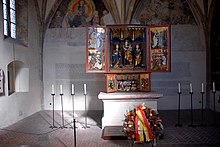Sankt Magdalena in Halltal

Sankt Magdalena im Halltal is a former monastery and today a destination with an inn in the Halltal in the Karwendel in Tyrol .
Location and accessibility
Sankt Magdalena lies on a terrace on the northern slopes of the Haller Zunterkopf at 1287 m above sea level. A. The almost circular forest clearing with the monastery church and the former chaplain, which is now the inn, is located roughly in the middle of the Hall valley. The escape route , which was built at the time of the salt mining, is ideal for hikers , as it was less exposed to the danger of avalanches from the Bettel Throw Massif due to its location on the northern slopes . In winter, Sankt Magdalena prepares a toboggan run through the Hall valley. If there is a risk of avalanches , the train has to be closed again and again, and it has a very demanding section with a gradient of 32 percent.
history
During archaeological excavations in recent years, numerous ceramic finds from the late Hallstatt period have been discovered near Sankt Magdalena ; the finds are likely to be related to salt mining.
In 1441 Hans Frankfurter , who was manager of the Haller Saline in the Salzmairamt from 1436 to 1440, retired to the Halltal to lead a hermit life. As Salzmaier, he was previously responsible for the administration and lower jurisdiction over the employees in the salt mine and the salt works. Frankfurter was one of the most respected officials in Tyrol. Soon a certain Heinrich joined him and a first chapel was built next to the hermitage, which was consecrated to St. Rupert , John the Baptist , Maria Magdalena , Barbara and the Apostle Matthew , among others . Duke Siegmund of Austria was very positive about the establishment and in 1447 arranged that a mass is read there every week. Shortly afterwards, the two brothers are said to have entered the Tegernsee Benedictine Abbey . But there are indications that Hans Frankfurter still lived in a hermitage in the area of the then diocese of Brixen even after 1448. On May 1, 1452 , Cardinal Nikolaus von Kues gave the two hermits their own rule and the recommendation to orientate themselves on the Benedictine Rule and other religious communities.
In the Halltal, two forest sisters from an association of the Kürrenberg Monastery in today's Baden were brought in to replace the orphaned hermitage . The sister community also received its own statutes from Nikolaus von Kues in 1452, which were closely based on the rule of St. Augustine . Despite the location on the shady side of an inhospitable valley, the sister community developed quite well. Duke Siegmund arranged for the sisters to have their own chaplain. In 1494, 24 sisters lived in the monastery. In 1490, the consecration day of the church, which was completed in 1486, was moved from the Sunday after the Assumption Day to the day of Mary Magdalene by the Brixen Prince-Bishop Cardinal Melchior von Meckau . This could also have given rise to the name of St. Magdalena . The founding of the daughter monastery of St. Martin in Gnadenwald around 1499 meant a break-in for the monastery. In addition to some sisters, some material possessions were also likely to have gone to the new foundation and some donations no longer reached the mother house. In view of the new monastery in sunny St. Martin, the remaining sisters also longed for a friendlier place and presented their requests to Emperor Maximilian . He had a monastery added to the church of St. Martin near Schwaz . In 1522 the sisters were able to move there. The monastery near Schwaz existed until it was repealed by Emperor Joseph II in 1782.
The empty monastery in the Halltal served the sovereigns as hunting quarters and in 1648 many Hallers fled from the plague to the lonely buildings. In the 17th century the church was baroque. The late Gothic winged altar was placed on a side wall in favor of a baroque altar, which was originally intended for the parish church of Absam . The valuable winged altar has been in the Hall war memorial chapel since 1923.
A severe earthquake in 1689 caused the monastery walls to collapse while the church held out. The accommodation for the chaplain was also rebuilt after the earthquake; this wing of the building has housed an inn since 1874. On February 14, 1888, an avalanche of dust from the opposite side of the valley badly damaged the monastery, so the roofs of the church and the chaplaincy were torn down. Between 1955 and 1957 the church was renovated.
literature
- Nikolaus Grass (ed.): St. Magdalena in Halltal. Studies on the legal history and sacred culture of a hermit and forest nunnery in the high mountains of Tyrol as well as on the monastery reform of Cardinal Cusanus , Verlag Wagner, Innsbruck 1970.
Web links
Individual evidence
- ↑ Hubert Gogl: Toboggan Guide Tirol, Verlag Tyrolia, Innsbruck 2008, ISBN 978-3-7022-2968-9 , pages 106 and 107.
- ^ Report from the University of Innsbruck ; accessed on January 8, 2010.
Coordinates: 47 ° 19 ′ 36.3 " N , 11 ° 29 ′ 35.1" E



